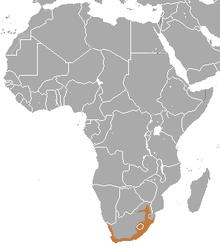Myosorex varius
| Myosorex varius | |
|---|---|
 |
|
| Drawing of M. varius | |
| Scientific classification | |
| Kingdom: | Animalia |
| Phylum: | Chordata |
| Class: | Mammalia |
| Order: | Eulipotyphla |
| Family: | Soricidae |
| Genus: | Myosorex |
| Species: | M. varius |
| Binomial name | |
|
Myosorex varius (Smuts, 1832) |
|
 |
|
| Forest shrew range | |
The forest shrew (Myosorex varius) is a species of shrew in the mouse shrew family, Soricidae. It is found in Lesotho, South Africa, and Swaziland. Its natural habitats include temperate forests, dry savanna, Mediterranean-type shrubby vegetation, and temperate grassland. The term "forest shrews" in the plural is sometimes confusingly used to collectively refer to a different genus, Sylvisorex.
The forest shrew grows to a length around 12.5 cm (5 in) with a tail of 4.3 cm (1.7 in) and an average mass of about 12 g (0.4 oz). In KwaZulu-Natal and the Drakensberg region, the males are larger than the females, but in the Cape Colony, the sexes are of similar sizes. This shrew is covered in short, dense fur, dark grey or brown above and paler underneath.
The forest shrew is native to South Africa, Lesotho, and Swaziland. In upland areas, it is often the commonest small mammal, but it is less common in coastal areas. It is found in a wide range of primary and secondary habitats, including forests, grassland, scrub, semidesert, karoo, and fynbos.
The forest shrew excavates a shallow burrow or takes over the burrow of another small mammal. The complex of passages has several entrances and a nesting chamber containing dry grasses. These shrews are territorial and a breeding pair of shrews is often found in a nest.
The forest shrew is mainly nocturnal and is an insectivore, but its diet also includes any small invertebrates it can find, including earthworms, millipedes, centipedes, crustaceans, and spiders. The forest shrew is preyed upon by barn owls, marsh mongooses, striped weasels, and striped polecats. To avoid predation, it spends most of its time in its burrow and only leaves when it needs to feed or defecate. Its droppings are very pungent.
...
Wikipedia

